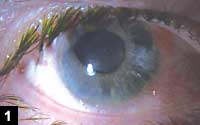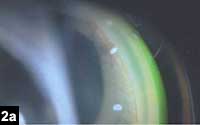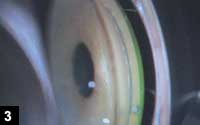Man presents with unilateral elevated IOP
Unilateral corectopia and corneal endothelial changes were noted on examination.

A 58-year-old white man was referred to the New England Eye Center’s glaucoma service for evaluation of unilateral elevation of IOP. He had no ocular complaints.
The patient’s ocular, family, medical and surgical histories were noncontributory. He had no known drug allergies.
 Shazia Ahmed |  My Hanh T. Nguyen |
The patient’s vision was 20/20 in both eyes with myopic corrections. Central corneal thickness was 599 µm in the right eye and 619 µm in the left eye. Both pupils were reactive with no relative afferent pupillary defect. Extraocular movements were full in both eyes. IOP was 26 mm Hg in the right eye and 15 mm Hg in the left eye.
External examination revealed an irregular right pupil. Slit lamp examination revealed right iris atrophy and corectopia (Figure 1). The right corneal endothelium displayed an irregular and highly reflective surface. Both anterior chambers were deep and quiet. Gonioscopy revealed broad, high peripheral anterior synechiae throughout the right eye angle (Figure 2) and normal angle structures in the left eye (Figure 3). The discs were noted to be symmetric in size and configuration with cup-to-disc ratios of 0.5 in both eyes. Dilated fundus examination demonstrated normal retinas.
Optical coherence tomography of the nerve fiber layer and visual field testing (24-2 SITA standard) showed no evidence of glaucomatous damage in either eye.
| ||
|
| ||
Images: Chaturvedi V, Krishnan C | ||

What is your diagnosis?
Elevated IOP, abnormal corneal endothelium
The classic differential diagnosis for a middle-age individual with unilateral iris changes, corneal endothelial changes and elevated IOP includes iridocorneal endothelial (ICE) syndrome, Axenfeld-Rieger syndrome, posterior polymorphous dystrophy (PPMD) and chronic sequelae from acute angle-closure glaucoma. Other conditions worth considering include Fuchs’ heterochromic iridocyclitis, Fuchs’ endothelial dystrophy, iris melanoma, glaucomatocyclitic crisis, latanoprost use, neovascular glaucoma, neurofibromatosis, siderosis and pigmentary glaucoma.
ICE syndrome is a unilateral, progressive condition most commonly affecting middle-age women. Patients with ICE do not usually have a family history of the disease or any systemic manifestations. Presenting symptoms are commonly ocular pain and decreased vision. The two most common sequelae of ICE are secondary angle-closure glaucoma and corneal edema. Patients also have iris abnormalities (atrophy, hole formation), a “hammered silver” appearance to the corneal endothelium and broad peripheral anterior synechiae.
Axenfeld-Rieger and PPMD are nonprogressive, autosomal dominant inherited conditions with bilateral manifestations. In Axenfeld-Rieger, patients have posterior embryotoxin (anteriorly displaced Schwalbe’s line) and variable other presentations, including iris strands to the peripheral cornea, iris atrophy and systemic manifestations (teeth and face changes). Patients with PPMD are usually asymptomatic and have corneal endothelial changes such as posterior vesicles, bands or placoid areas. Patients with PPMD can develop glaucoma at any age.
Chronic sequelae from acute angle-closure glaucoma can include iris transillumination defects, peripheral anterior synechiae and an irregular pupil. However, corneal endothelial changes are absent and synechiae usually do not extend to Schwalbe’s line.
This patient was diagnosed with ICE syndrome based on his clinical findings.
Clinical entities and pathophysiology
The first description of ICE syndrome is credited to Harms in 1903. In 1956, Chandler described a syndrome with glaucoma, iris atrophy and endothelial dystrophy (Chandler’s syndrome). In 1965, it was found that Chandler’s syndrome and progressive iris atrophy were different forms of the same disease. In 1969, Cogan and Reese described two patients with iris nodules and glaucoma.
ICE syndrome represents a clinical spectrum of disease. Corneal manifestations (endothelial dystrophy leading to corneal edema) and subtle iris displacement are the predominant findings in Chandler’s syndrome. Iris atrophy, hole formation (pseudopolycoria) and corectopia are the hallmarks of progressive iris atrophy. In iris nevus syndrome (Cogan-Reese), the anterior iris stroma is covered with tan, pedunculated or sessile nodules. There can be significant overlap among these subcategories of ICE syndrome.
In 1978, Campbell unified all three basic forms of ICE under one pathology. He reviewed 82 patients with a variety of clinical manifestations of ICE syndrome and concluded that the underlying factor was the formation of an aberrant membrane derived from the corneal endothelium. This membrane progresses to cover the angle and iris, leading to iris contracture and displacement, iris atrophy, iris hole and nodule formation, peripheral anterior synechiae and elevated IOP. The cellular anatomy of this membrane has been extensively studied. It has been found that the endothelial cells of this membrane display characteristics of epithelial cells. The cells have microvilli and filopodial cytoplasmic processes, consistent with the ability of the membrane to migrate over the angle and iris.
The pathogenesis of ICE has been well studied. Inflammatory, neoplastic and embryonic etiologies have all been investigated. More recently, Alvarado and colleagues examined corneas from patients with ICE syndrome and compared these corneas with healthy corneas, herpes simplex infected corneas and corneas from patients with other forms of chronic corneal disease (bullous keratopathy, interstitial keratitis and keratoconus). Polymerase chain reaction studies on the corneas revealed that a significant number of patients with ICE syndrome were positive for the herpes virus, whereas those with healthy corneas and chronic corneal diseases were not. Furthermore, when the endothelium was removed in patients with ICE syndrome, the corneas were no longer positive for the herpes virus. They concluded that in patients with ICE syndrome, the metaplasia of corneal endothelial cells into epithelial cells is caused by a virus.
Diagnosis and treatment
ICE syndrome is a clinical diagnosis. However, specular microscopy can be used to distinguish difficult cases of ICE. Whereas normal corneal endothelial cells have a white appearance with black intercellular junctions on specular microscopy, there is a “light to dark” reversal in patients with ICE syndrome. The endothelial cells of these patients appear black and the intercellular junctions are white.
Management of IOP in patients with ICE syndrome can be difficult. Laser trabeculoplasty is not indicated due to the pathogenesis of the condition. Aqueous suppressants are typically first-line therapy, including carbonic anhydrase inhibitors, beta-blockers and alpha agonists. Miotics and prostaglandins have been found to be less efficacious. Long-term IOP control with medical therapy is often unsuccessful, and surgical intervention is often needed to adequately control IOP. There have been several studies examining surgical outcomes, highlighting the variable success rates and difficulty in managing these patients. Laganowski found that the survival rate for trabeculectomy without antifibrotics in patients with ICE syndrome is 21% at 5 years. Kim and colleagues found in a retrospective study of 10 patients with ICE syndrome that IOP could be controlled with glaucoma drainage implants. However, patients often underwent multiple procedures and suffered complications, including blockage of the tube ostium (by the iris or aberrant corneal endothelial membrane) and membrane-induced tube migration. Doe and colleagues compared 12 patients who underwent trabeculectomy with antifibrotics and 14 patients who underwent drainage implantation. The average IOP and number of medications decreased postoperatively for both groups. The 5-year survival rates for trabeculectomy and drainage implants were 29% and 53%, respectively.
To our knowledge, no recommendations regarding anti-viral therapy for patients with ICE syndrome exist in the literature. However, based on a viral-induced hypothesis, antiviral therapy could have a role. Future studies are needed to investigate the use of antivirals in patients with ICE syndrome.
Our patient with ICE syndrome was diagnosed with the sub-entity of progressive iris atrophy. He was started on timolol 0.5% once daily and valacyclovir 500 mg once daily. His last IOP (6 months since starting therapy) was 20 mm Hg in the right eye.
For more information:
- Vivek Chaturvedi, MD, and Chandrasekharan Krishnan, MD, can be reached at New England Eye Center, Tufts University School of Medicine, 750 Washington St., Box 450, Boston, MA 02111; 617-636-4219; fax: 617-636-4866; Web site: www.neec.com.
- Edited by Shazia Ahmed, MD, and My Hanh T. Nguyen, MD. Drs. Ahmed and Nguyen can be reached at New England Eye Center, Tufts University School of Medicine, 750 Washington St., Box 450, Boston, MA 02111; 617-636-4219; fax: 617-636-4866; Web site: www.neec.com. Drs. Ahmed and Nguyen have no direct financial interest in the products mentioned in this article, nor are they paid consultants for any companies mentioned.
References:
- Alvarado JA, Underwood JL, et al. Detection of herpes simplex viral DNA in the iridocorneal endothelial syndrome. Arch Ophthalmol. 1994;112(12):1601-1609.
- Balin CF, Falls HF, et al. Classification of corneal endothelial disorders based on neural crest origin. Ophthalmology. 1984;91(6):558-563.
- Doe EA, Budenz DL, Gedde SJ, Imami NR. Long-term surgical outcomes of patients with glaucoma secondary to the iridocorneal endothelial syndrome. Ophthalmology. 2001;108(10):1789-1795.
- Kim DK, Aslanides IM, et al. Long-term outcome of aqueous shunt surgery in ten patients with iridocorneal endothelial syndrome. Ophthalmology. 1999;106(5):1030-1034.
- Laganowski HC, Kerr Muir MG, Hitchings RA. Glaucoma and the iridocorneal endothelial syndrome. Arch Ophthalmol. 1992;110(3):346-350.
- Laganowski HC, Sherrard ES, Muir MG, Buckley RJ. Distinguishing features of the iridocorneal endothelial syndrome and posterior polymorphous dystrophy: Value of endothelial specular microscopy. Br J Ophthalmol. 1991;75(4):212-216.
- Lucas-Glass TC, Baratz KH, et al. The contralateral corneal endothelium in the iridocorneal endothelial syndrome. Arch Ophthalmol. 1997;115(1):40-44.
- Shields MB. Axenfeld-Rieger syndrome: a theory of mechanism and distinctions from the iridocorneal endothelial syndrome. Trans Am Ophthalmol Soc. 1983;81:736-784.




